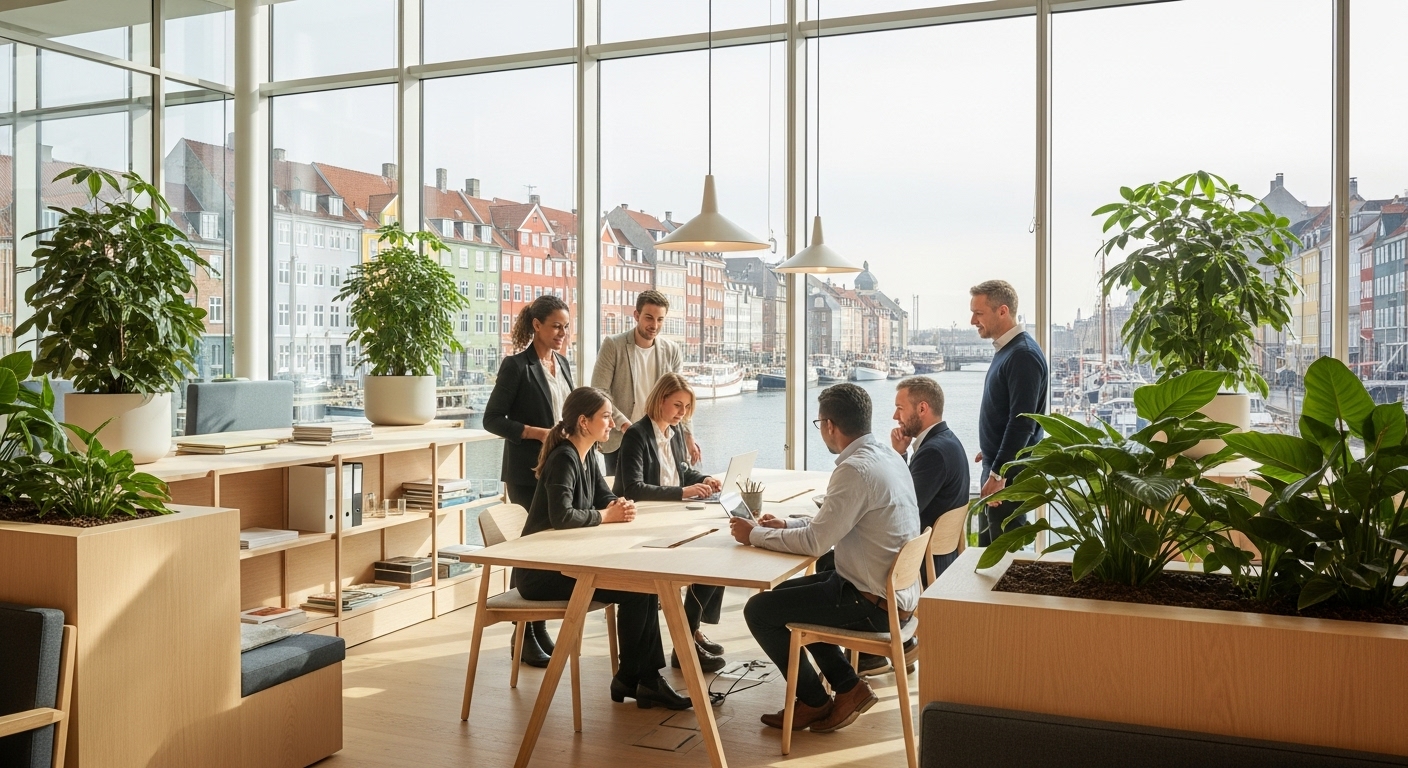In the world of corporate workspace strategy, location analysis has long been a discipline dominated by hard numbers: cost per square foot, logistical efficiency, and proximity to markets. These metrics are vital, but in today’s talent-driven economy, they tell only half the story. A new, more human-centric variable is emerging as a critical differentiator—the Danish concept of ‘hygge’. This idea of cozy contentment and well-being is more than a cultural quirk; it’s a strategic asset. When integrated into location analysis, it forces a re-evaluation of what makes a business location truly optimal. This article explores how the ‘hygge effect’—a focus on employee well-being, sustainability, and community—is revolutionizing location analysis. We will use the city of Copenhagen, the concept’s heartland, as a living case study to demonstrate how these qualitative factors translate into tangible competitive advantages, from attracting elite talent to building a resilient, future-proof brand.
Redefining the pillars of modern location analysis
The traditional pillars of location analysis—cost, infrastructure, and market access—remain foundational, but they are no longer sufficient to secure a long-term competitive edge. A modern framework must incorporate a new set of pillars that reflect the values of the contemporary workforce and the realities of a changing global climate. The first new pillar is Talent Well-being. This goes beyond salary and benefits to encompass work-life balance, mental health support, and the quality of the surrounding environment. The second is Sustainability. A company’s physical location is a powerful statement of its environmental commitment, impacting everything from brand perception to regulatory compliance and operational efficiency. The third pillar is the Innovation Ecosystem. Success is increasingly dependent on connectivity to a vibrant network of startups, academic institutions, and industry peers that foster collaboration and spark new ideas. Finally, Cultural Alignment ensures that the values of the location resonate with the desired corporate culture. Choosing a location is no longer just a real estate decision; it’s a strategic move that defines a company’s identity and its ability to attract and retain the people who will drive its future. These new pillars demand a more nuanced, qualitative approach to data, shifting the focus from a simple cost-benefit analysis to a holistic value assessment.
The talent dividend: Why well-being is the new currency
In the global war for talent, the most compelling offer isn’t always the highest salary; it’s the highest quality of life. This is where the ‘hygge effect’ becomes a powerful tool in location analysis. A city’s ability to provide a healthy work-life balance, safe and clean public spaces, and a strong sense of community is a direct driver of talent attraction and retention. For instance, companies choosing a base in Copenhagen are not just offering a job; they are offering access to a lifestyle renowned for its emphasis on family, leisure, and personal well-being. This environment reduces employee burnout, lowers attrition rates, and boosts overall productivity. Analyzing a location through this lens means looking at data points like average commute times, access to green spaces, affordability of childcare, and public health outcomes. These factors directly impact an employee’s daily life and, consequently, their engagement and loyalty at work. By prioritizing a location that invests in its citizens’ well-being, a company is effectively investing in the long-term health and performance of its own workforce, creating a ‘talent dividend’ that pays off for years to come.
The green blueprint: Factoring sustainability into your ROI
Sustainability has evolved from a corporate social responsibility checkbox to a core business imperative. A location’s environmental credentials are now a critical factor in strategic analysis, influencing brand reputation, operational costs, and access to talent. A city with a strong green agenda offers businesses a significant head start. This includes access to renewable energy grids, robust public transportation networks that reduce reliance on cars, and a commercial real estate market dominated by energy-efficient, green-certified buildings. These features not only reduce a company’s carbon footprint but also lead to tangible cost savings on utilities and can unlock access to green financing and tax incentives. Furthermore, a sustainable location acts as a powerful magnet for top talent, particularly among younger generations who prioritize working for environmentally conscious employers. Analyzing a location for its ‘green blueprint’ involves assessing its climate action plans, recycling rates, air quality indices, and the prevalence of standards like LEED or BREEAM. It’s a forward-looking analysis that positions a company to be resilient in the face of future climate regulations and attractive to an increasingly eco-aware market.
Tapping into the innovation ecosystem
No company innovates in a vacuum. The most groundbreaking ideas often emerge from the collision of different industries, disciplines, and cultures. Therefore, a crucial element of modern location analysis is mapping a city’s innovation ecosystem. This involves identifying the density and quality of key institutions like universities, research labs, venture capital firms, and industry-specific clusters. Proximity to these entities creates invaluable opportunities for formal partnerships, talent recruitment, and the kind of informal knowledge-sharing that happens in cafes and co-working spaces. A thriving ecosystem provides a steady pipeline of new ideas and skilled graduates, reducing R&D costs and accelerating the pace of innovation. When analyzing a potential location, it’s essential to look beyond the mere presence of these institutions and evaluate the strength of the connections between them. Metrics to consider include the volume of patents filed, the amount of venture capital invested, and the number of university-industry collaborations. The goal is to find a location that isn’t just a place to do business but is an active participant in your company’s growth and evolution, a role expertly filled by hubs like Copenhagen with its world-class universities and thriving tech scene.
Digital and physical connectivity as a strategic backbone
While human-centric factors are on the rise, the fundamental importance of connectivity remains absolute. A strategic location must serve as a seamless gateway to regional and global markets, supported by both physical and digital infrastructure. On the physical side, this means world-class logistics, including efficient airports with extensive international routes, modern ports, and integrated public transportation that ensures employees and clients can move around easily. This infrastructure is the circulatory system of a business, enabling the smooth flow of goods, people, and services. Digitally, robust, high-speed internet, secure data centers, and widespread network coverage are non-negotiable. This digital backbone supports everything from global video conferencing and cloud computing to the development of data-intensive AI and IoT products. When conducting a location analysis, it’s not enough to confirm that this infrastructure exists; one must assess its reliability, scalability, and future-readiness. Evaluating a city’s investment plans for 5G rollout, fiber optic expansion, and transport upgrades provides insight into its long-term viability as a strategic business hub.
A case study in practice: The Medicon Valley advantage
The Øresund Region, with Copenhagen at its heart, offers a perfect real-world example of these modern location analysis principles in action. The Medicon Valley life sciences cluster is one of the most powerful in Europe, and its success is a direct result of the convergence of all the pillars we’ve discussed. The region boasts a highly educated talent pool drawn from world-class universities, attracted not only by professional opportunities but by the exceptional quality of life. This is the ‘hygge effect’ driving talent acquisition. The ecosystem is incredibly dense, with a mix of major pharmaceutical corporations, innovative biotech startups, research hospitals, and academic institutions fostering a culture of open collaboration. Sustainability is deeply embedded, with companies operating from state-of-the-art, energy-efficient facilities. Finally, the physical and digital connectivity is superb, with Copenhagen Airport providing a gateway to the world and seamless infrastructure connecting Denmark and Sweden. Medicon Valley demonstrates that when a location can deliver on talent well-being, ecosystem vibrancy, and robust infrastructure, it creates a self-reinforcing cycle of growth and innovation, making it a prime target for any strategic location analysis in the life sciences sector.
Ultimately, the art and science of location analysis are undergoing a profound transformation. The spreadsheets and cost models of the past are being augmented by a richer, more holistic understanding of value. The ‘hygge effect’ is not just a lifestyle trend; it is a strategic lens through which to view potential locations, prioritizing the human factors that fuel innovation, attract top-tier talent, and build a resilient, purpose-driven organization. By integrating metrics for well-being, sustainability, and ecosystem health into their decision-making frameworks, businesses can move beyond simply finding an efficient place to operate. They can identify a true strategic partner in their growth—a location that reflects their values and actively contributes to their long-term success. As companies navigate an increasingly complex global landscape, this human-centric, data-informed approach to choosing a workspace is no longer a luxury but a fundamental necessity for building a company that is not only profitable but also sustainable and deeply attractive to the people who matter most.





